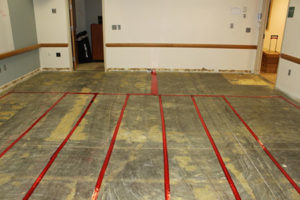Facility Upgrades Endanger Existing Hearing Loops
Recently, a meeting room for hard-of-hearing people got an AV upgrade. New ceiling PA microphones were installed together with some other refined audio gear. Afterwards, the hearing loop no longer worked. Hopefully, the workers only forgot to reconnect the loop and did not cut the wires or remove equipment, thereby destroying the system.
Once they have been professionally installed and certified, hearing loops are pretty much maintenance-free. They are tied into the other AV equipment and work on their own, automatically and without fuss. And so, it is easy to forget about them.
Include existing hearing loops on project management checklists!
Project managers must make sure that existing hearing loops are not forgotten and are not harmed during during any renovation jobs. All to often workers and even electrical and AV contractors are not familiar with hearing loop systems and do not recognize the set-ups. This is why hearing loop wires and electronics must be identified for any workers before any refurbishment jobs begin.
Once the work is completed, the testing and verification of proper loop function is a project management responsibility. After extensive updates, the loops might have to be recalibrated in order to continue to meet the requirements of the IEC 60118-4 (International Electrotechnical Commission) loop performance standard. And so, hearing loop concerns during facility upgrades definitely deserve a place on project management checklists!
What can go wrong?
- Physical damage. Wires hidden under carpeting or floor tiles are often cut during floor renovations. Yet, loop wires can also be installed in other locations, even along ceilings which makes them vulnerable to being pulled or damaged.
- Hearing loop signage maybe be removed and never replaced. Hard-of-hearing people will not know that the venue has a loop and the loop will not be used.
- Loop wires are disconnected from their specialized amplifier and the amplifier itself might be removed from the electrical cabinet.
- Disconnected loops are not reconnected to existing or upgraded AV features.
- Hearing loop function is not tested at the end of the job. Loops are left inactive, damaged or malfunctioning.
- Loops are not recalibrated for best function and compliance. As a result of invasive construction, electrical and/or AV work, hearing loops may be out of compliance with required performance standards. Failure to recalibrate will result in substandard loop performance. Project managers must see that this does not happen. Yet another reason to test the loops after any job completion!
For all these reasons, existing hearing loops must be included on the project management checklists during facility upgrades. They cannot be forgotten. They have to be protected from physical damage. At the end of the refurbishment job, loops must be tested. They must be integrated with any previous or upgraded AV features and comply with IEC standards.
*****
To learn more about hearing loss, also visit my website https://hearing-loss-talk.com/


Comments
Facility Upgrades Endanger Existing Hearing Loops — No Comments
HTML tags allowed in your comment: <a href="" title=""> <abbr title=""> <acronym title=""> <b> <blockquote cite=""> <cite> <code> <del datetime=""> <em> <i> <q cite=""> <s> <strike> <strong>